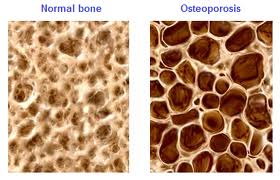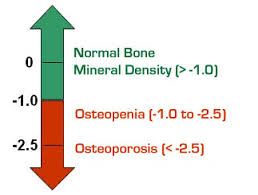You’ve heard that osteoporosis is called the ‘silent killer’. But why is it? Because it sneaks up quietly without warning. It is a disease characterized by weak, thin, porous bones that makes fracture (and dire complications from it) highly likely.
A combination of a poor diet and lack of exercise is generally the cause. But it’s a slow symptom free process that takes place unknowingly over decades. It sets the stage for fractured bones – often from innocent bumps and falls that previously wouldn’t have harmed you.
Only when this happens do your doctor’s suspicions become aroused, and then he’ll likely send you for a DEXA test to measure your bone density. That’s usually how osteoporosis is discovered.
But by then it’s often too late, as a fracture late in life will interrupt your exercise routine and begin a downward spiral of physical degeneration that is so hard to recover from.
This is not mere speculation. The statistics show that the 6 month mortality rate from osteoporosis fractures and the complications that result is 13.5%!(1)
Frightening! But it doesn’t have to be once you understand that it’s not fate, but your everyday choices and habits that will literally make or break you. As mentioned earlier, it’s pretty much an equal combination of diet and exercise that determines whether you get osteoporosis or not.
Let’s look at diet. But before you shudder at yet another diet plan, be encouraged that the benefits of following an osteoporosis diet plan are numerous, and extend well beyond bone health.
If you do start to follow an osteoporosis diet plan, know that you’ll be following a diet that also leads to your:
– ideal weight
– optimum energy
– best and healthiest hair skin and nails, and more.
And it’s not new – it is a type of diet that has been recommended countless times but called different names.
It is the diet of the ages and has been followed by most people for most of history. Cleopatra, known for her beautiful skin, ate this way.
Helen of Troy had a face that was capable of launching a thousand ships, because she too followed this diet.
What is this diet of which I speak?
Your Great Grandparents’ Diet:
Your bones will thank you and serve you well for life if you simply eat as your great grandparents (and their parents, and their parents) did.
They did not have access to packaged, processed, refined foods, and for that they were lucky. They typically ate fresh vegetables and meats. By doing this, they got all the vitamins and minerals the bones needed.
Sweets were small, few and far between. 300 years ago, average sugar consumption per person was about one pound per year. A published U.S. Department of Agriculture report revealed that the average American now consumes 156 pounds of sugar a year! (2)
This is very important to consider, because sugar is a main culprit of osteoporosis, as it so effectively depletes the bones of calcium.
You’ve heard or seen how leaving a tooth in a cup of coke will dissolve it within days? Well next time you reach for a soda, picture this same image, as it’s not far off what it does to your bones.
“Sugar depletes the body of phosphorus, and without adequate phosphorus for transport, bone marrow doesn’t get the calcium it needs, so the body pulls calcium from bones.” – Dr. Rick Allen.
Mass produced ‘food’ items that fill up the middle aisles of your supermarket sure are convenient, but lack the same amount of nutrients, vitamins and minerals that fresh, unprocessed foods have.
Today’s generation filled up on these processed mineral depleted foods as kids, and started a lifetime of what became habits. It seemed these foods were doing their nutritional job, but it was a kind of trap.
Because youth have lots of natural energy, the effects of poor nutrition are almost invisible on the young. But they’re on the distant horizon that is adulthood.
By our adult years, the previous years of poor nutrition will start to show, and osteoporosis is one of the prices we pay for our modern, convenience based lifestyles.
But you may be confused because you were taught that calcium is all you need to ensure strong bones. And so you’ve been good about getting lots of calcium. This message has always been advantageous for the sales of calcium filled dairy products, but is not quite truthful.
Because science tells a different story of what we need: the bones are actually made up of a complex array of many minerals, so you must eat food that contains not just calcium, but also these same minerals inside you.
In fact, calcium relies on a host of other vitamins and minerals to be able to get, and stay in your bones. This explains why Norway, Sweden, Iceland, Denmark and the USA, that consume the highest levels of calcium, also sport the highest levels of osteoporosis.(3)
The good news is the body is very resilient and responsive to change.
For example, heavy smokers have been shown to have bright pink lungs within a year or so of quitting. Most obese people are able to shed a lifetime of unwanted weight quickly once they dramatically change destructive habits and simply switch from packaged, processed, and fast, to wholesome, simple and traditional foods.
And there are cases of people beating osteoporosis with regular exercise, and turning their backs on the S.A.D. (Standard American Diet) which is fast, fried, packaged, processed, high sodium and sugar food and drink.
And the winning formula is simple – much more so than deciding amongst the thousands of packaged products that actually do us harm. Shopping trips are an assault on our brains and our wallets as marketers exist only to part us with our money.
So stick to the outside aisles of your supermarket where the fresh items are and buy the simple, traditional food groups.
For example, instead of deciding between the hundreds of processed corn based products, just buy real fresh corn! You’ll be in and out of the supermarket in half the time with food that is double in nutritional value.
Osteoporosis Diet Plan – Dos and Don’ts
The following foods and drinks are listed because they are either: high in calcium and other minerals and are alkaline, therefore allies in the fight against osteoporosis.
Or they are the opposite – low in the necessary minerals and/or acidic and increase your chance of osteoporosis.
Do Eat (As Much as Possible):
– Fresh fruits (oranges, dates, olives)
– Vegetables (turnip greens, kale, collards, spinach, broccoli)
– Legumes
– Nuts (Brazil nuts, almonds)
– Fish (herring, salmon, sardines).
Don’t Eat (Or Eat As Little as Possible):
– Sodas
– Refined, processed packaged foods
– Excessive amounts of animal proteins
– Excessive sodium and table salt
– Coffee (limit to one or two per day as caffeine leaches calcium from the bones)
– Soy products, as the oxalates can bind up calcium and make it unavailable to the body
Eating like our ancestors will be a great start to stronger bones. However, because of mass farming, today’s foods don’t have the same vitamin and mineral content that they did back in the old days.
In fact many of the most popular fruit and vegetables have much less vitamins and minerals in them than they did even 50 years ago.
The common apple, for example, has an average of 62% less of the 5 most common minerals than it did 80 years ago! (4)
For this reason, bone health supplements are wise and cheap insurance to make sure your bases are covered.
Most bone health products are sourced from rock (usually labelled as calcium carbonate, calcium citrate) and contain only calcium and vitamin D. They have been a staple product for decades and were at a time useful as they are capable of slowing down bone loss.
However, AlgaeCal is a 100% plant based product that contains not just calcium, but a full spectrum of minerals that are crucial for bone building.
Because it’s full of valuable minerals, highly absorbable and body friendly, AlgaeCal has been clinically supported to actually increase bone density. A big difference from typical rock sourced calcium pills that merely slow bone loss.
It’s good to know that AlgaeCal is also ecologically friendly: hand harvested in small batches, it’s the only plant calcium that is USDA Certified Organic.
References:
1. Hannan EL, Magaziner J, Wang JJ, et al. (2001). “Mortality and locomotion 6 months after hospitalization for hip fracture: risk factors and risk-adjusted hospital outcomes”. JAMA 285 (21): 2736–42. doi:10.1001/jama.285.21.2736. PMID 11386929.
2. http://www.theonion.com/articles/report-average-american-consumes-156-pounds-of-sug,29419/
3. Kanis JA, Johnell O, De Laet C, et al. (2002) International variations in hip fracture probabilities: implications for risk assessment. J Bone Miner Res 17:1237.
4. http://www.nutritionsecurity.org/PDF/Mineral Content of One Apple.pdf







Di
April 10, 2013 , 1:16 pmIs this product in powder form. What is the absorbtion rate?